Related Research Articles
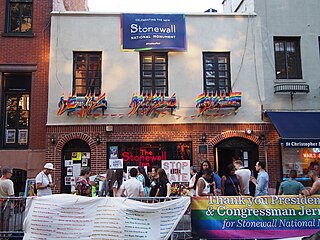
A gay village, also known as a gayborhood, is a geographical area with generally recognized boundaries that is inhabited or frequented by many lesbian, gay, bisexual, transgender, and queer (LGBTQ) people. Gay villages often contain a number of gay-oriented establishments, such as gay bars and pubs, nightclubs, bathhouses, restaurants, boutiques, and bookstores.

The LGBTQ community is a loosely defined grouping of lesbian, gay, bisexual, transgender, and queer or questioning individuals united by a common culture and social movements. These communities generally celebrate pride, diversity, individuality, and sexuality. LGBTQ activists and sociologists see LGBTQ community-building as a counterweight to heterosexism, homophobia, biphobia, transphobia, sexualism, and conformist pressures that exist in the larger society. The term pride or sometimes gay pride expresses the LGBTQ community's identity and collective strength; pride parades provide both a prime example of the use and a demonstration of the general meaning of the term. The LGBTQ community is diverse in political affiliation. Not all people who are lesbian, gay, bisexual, or transgender consider themselves part of the LGBTQ community.

LGBTQ culture is a culture shared by lesbian, gay, bisexual, transgender, and queer individuals. It is sometimes referred to as queer culture, LGBT culture, and LGBTQIA culture, while the term gay culture may be used to mean either "LGBT culture" or homosexual culture specifically.
Over the course of its history, the LGBTQ community has adopted certain symbols for self-identification to demonstrate unity, pride, shared values, and allegiance to one another. These symbols communicate ideas, concepts, and identity both within their communities and to mainstream culture. The two symbols most recognized internationally are the pink triangle and the rainbow flag.
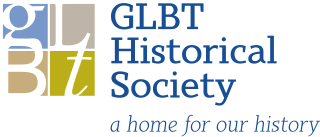
The GLBT Historical Society maintains an extensive collection of archival materials, artifacts and graphic arts relating to the history of LGBTQ people in the United States, with a focus on the LGBT communities of San Francisco and Northern California.
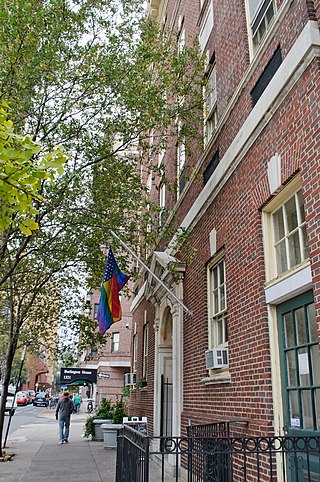
The William Way LGBT Community Center is a nonprofit organization serving the lesbian, gay, bisexual and transgender population of Philadelphia, Pennsylvania and nearby communities, located at 1315 Spruce Street in Philadelphia in the Gayborhood.
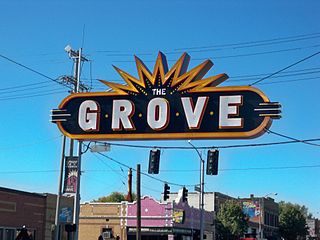
The Grove is a business district located along Manchester Avenue between Kingshighway Boulevard and Vandeventer Avenue in the Forest Park Southeast (FPSE) neighborhood of St. Louis, Missouri. Formerly known as the Manchester Strip, the retail drag was first developed in the late 19th century to serve the working-class population of Forest Park Southeast. Today, the Grove is home to a variety of restaurants, bars, and clubs, including a significant number of LGBT-oriented establishments. The district is supported by a community improvement district (CID), created in 2009, which levies an additional sales tax on businesses within its boundaries to fund infrastructure and branding services.
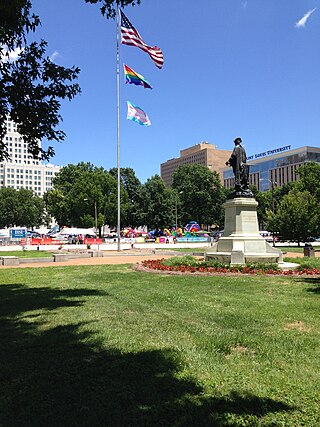
PrideFest St. Louis is an annual LGBT pride event in St. Louis, Missouri. The event is organized by Pride St. Louis, an LGBT non-profit organization in the Greater St. Louis area. Between 350,000-500,000 people attend the two day festival and grand parade.

The development of LGBT culture in Philadelphia can be traced back to the early 20th century. It exists in current times as a dynamic, diverse, and philanthropically active culture with establishments and events held to promote LGBT culture and rights in Philadelphia and beyond.

LGBTQ culture in Portland, Oregon is an important part of Pacific Northwest culture.

The lesbian, gay, bisexual and transgender (LGBTQ) community in San Francisco is one of the largest and most prominent LGBT communities in the United States, and is one of the most important in the history of American LGBT rights and activism alongside New York City. The city itself has been described as "the original 'gay-friendly city'". LGBT culture is also active within companies that are based in Silicon Valley, which is located within the southern San Francisco Bay Area.

New York City has been described as the gay capital of the world and the central node of the LGBTQ+ sociopolitical ecosystem, and is home to one of the world's largest and most prominent LGBTQ+ populations. Brian Silverman, the author of Frommer's New York City from $90 a Day, wrote the city has "one of the world's largest, loudest, and most powerful LGBT communities", and "Gay and lesbian culture is as much a part of New York's basic identity as yellow cabs, high-rise buildings, and Broadway theatre". LGBT travel guide Queer in the World states, "The fabulosity of Gay New York is unrivaled on Earth, and queer culture seeps into every corner of its five boroughs". LGBTQ advocate and entertainer Madonna stated metaphorically, "Anyways, not only is New York City the best place in the world because of the queer people here. Let me tell you something, if you can make it here, then you must be queer."
Throughout Dallas–Fort Worth, there is a large lesbian, gay, bisexual, and transgender community. Since 2005, DFW has constituted one of the largest LGBT communities in Texas.
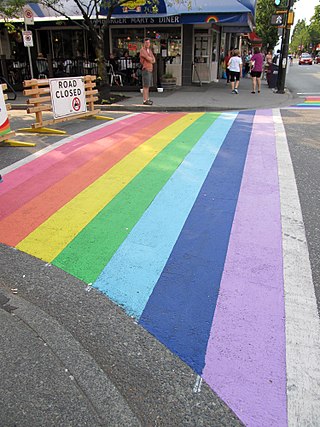
Vancouver's LGBT community is centered on Davie Village. Commercial Drive has historically acted as a gayborhood for the Vancouver lesbian community. Historically, LGBT people have also gathered in the Chinatown and Gastown neighborhoods. Former establishments include Dino's Turkish Baths, a gay bathhouse on Hastings, and the city's first drag bar, BJ's, on Pender Street.

LGBT culture in Baltimore, Maryland is an important part of the culture of Baltimore, as well as being a focal point for the wider LGBT community in the Baltimore metropolitan area. Mount Vernon, known as Baltimore's gay village, is the central hub of the city's lesbian, gay, bisexual, and transgender communities.

The ongoing COVID-19 pandemic has highlighted inequities experienced by marginalized populations, and has had a significant impact on the LGBT community. Pride events were cancelled or postponed worldwide. More than 220 gay pride celebrations around the world were canceled or postponed in 2020, and in response a Global Pride event was hosted online. LGBTQ+ people also tend to be more likely to have pre-existing health conditions, such as asthma, HIV/AIDS, cancer, or obesity, that would worsen their chances of survival if they became infected with COVID-19. They are also more likely to smoke.

In Washington, D.C., LGBT culture is heavily influenced by the U.S. federal government and the many nonprofit organizations headquartered in the city.

Istanbul is generally tolerant of LGBTQ people, at least compared to elsewhere in Turkey.
References
- ↑ "Top Places for LGBTQ Folks to Live—and It's Not Just New York and San Francisco". Real Estate News and Advice | Realtor.com®. 2019-06-24. Retrieved 2020-09-02.
- ↑ Cox, Kallie. "Red State Refugees: Fed-Up St. Louisans Are Fleeing Missouri for Illinois". Riverfront Times. Retrieved 2024-03-13.
- 1 2 "What Does the Future of Pride Look Like — in a City with Many Pride Celebrations?". Out in STL. 2017-09-20. Retrieved 2019-05-09.
- ↑ Crone, Thomas (2014-05-27). "Tower Grove Pride Returns for Year Two". www.stlmag.com. Retrieved 2019-05-09.
- ↑ Farzan, Shahla (22 June 2018). "Organizers expect thousands at Pride events in St. Louis this weekend". news.stlpublicradio.org. Retrieved 2019-05-09.
- ↑ Fenske, Sarah (Jun 27, 2019). "'Trans & Gender-Free Pride March' Friday Offers 'Police-Free' Alternative". Riverfront Times. Retrieved 2019-08-28.
- ↑ Lauren Saiko. "Missouri ranked in lowest category for LGBTQ protections, nondiscrimination". The Standard. Retrieved 2019-05-30.
- ↑ "City of St. Louis, Civil Right Enforcement Agency Reaching Out to LGBT Community". The Vital Voice. 2011-12-29. Archived from the original on 2019-05-30. Retrieved 2019-05-30.
- ↑ Campaign, Human Rights. "Cities & Counties w/ Non-Discrim Ordinances that Include Gender". Human Rights Campaign. Retrieved 2019-06-12.
- ↑ Hauser, Christine (2017-02-17). "'Tone Down Your Gayness': St. Louis Police Officer Files Discrimination Suit". The New York Times. ISSN 0362-4331 . Retrieved 2019-06-12.
- ↑ Wakefield, Lily (2020-02-12). "Police officer told to 'tone down his gayness' to get a promotion walks away from lawsuit a multi-millionaire". PinkNews. Retrieved 2020-02-26.
- ↑ Whithaus, Rhonda. "Library Guides: Native American/Indigenous Studies: MO Indigenous Nations". libraryguides.missouri.edu. Retrieved 2019-08-08.
- ↑ Pruden, Harlan and Edmo, Se-ah-dom. "Two-Spirit People: Sex, Gender & Sexuality in Historic and Contemporary America." National Congress of American Indians. http://www.ncai.org/policy-research-center/initiatives/Pruden-Edmo_TwoSpiritPeople.pdf
- ↑ O'Neil, Tim. "Look Back 250 • Osage Indians pushed out by arriving Americans in 1808". stltoday.com. Retrieved 2019-08-08.
- ↑ Hartland, Claude (2005). Claude Hartland: the story of a life : for the consideration of the medical fraternity. ISBN 9781410108715. OCLC 840899936.
- ↑ "Downtown St. Louis: A Proud History". #Boom Magazine. Retrieved 2019-08-05.
- ↑ SONSTEGARD, ADAM (2002). "Performing the "Unnatural" Life: America's First Gay Autobiography". Biography. 25 (4): 545–568. ISSN 0162-4962. JSTOR 23540781.
- ↑ "LGBT History Month 2018 | Washington University in St. Louis". 2018-10-03. Retrieved 2019-07-30.
- ↑ Johnson, Kevin C. "Female impersonators will go all out at Miss Fannie's Ball". stltoday.com. Retrieved 2019-07-30.
- 1 2 Berry, Emanuele (29 October 2014). "Halloween Arrests In The 1960s Sparked St. Louis' LGBT Movement". news.stlpublicradio.org. Retrieved 2019-06-03.
- ↑ "St. Louis' Stonewall". The Vital Voice. 2012-10-01. Archived from the original on 3 Jun 2019. Retrieved 2019-06-03.
- ↑ "The Tearoom Trade | SexInfo Online". www.soc.ucsb.edu. Archived from the original on 2014-02-02. Retrieved 2019-06-13.
- 1 2 Meinzer, Melissa. "Gay Old Times: It's LGBT history to us. To them, it was life". Riverfront Times. Retrieved 2019-07-29.
- 1 2 "Beyond Gender Binaries: Mapping LGBTQ St. Louis". wustl.maps.arcgis.com. Retrieved 2019-07-30.
- 1 2 3 4 "GLTB History in St. Louis". jandris.ipage.com. Retrieved 2019-06-12.
- ↑ "Metropolitan Community Church of Greater St. Louis (1973 - ) | Collections | LGBTQ Religious Archives Network". lgbtqreligiousarchives.org. Retrieved 2019-06-13.
- 1 2 Dent, Emma (Apr 12, 2018). "Nonprofit Spotlight: Saint Louis Effort for AIDS". Ladue News. Retrieved 2019-08-28.
- 1 2 3 "The Impact of Segregation: Mapping LGBTQ St. Louis, 1945-1992". wustl.maps.arcgis.com. Retrieved 2019-07-30.
- ↑ "History alumnus, teacher Rodney Wilson reflects on LGBT History Month's beginnings". UMSL Daily. 2015-10-07. Retrieved 2019-06-12.
- ↑ Braxton. "Why St. Louis Black Pride Festival is Important". #Boom Magazine. Retrieved 2019-07-30.
- ↑ Henderson, Andrea Y. (2021-11-03). "Pride St. Louis to close its LGBTQ community center, citing financial reasons". STLPR. Retrieved 2024-03-13.
- ↑ Fowler, Nancy (2015-06-05). "St. Louis' LGBT Center abandons plans to buy building; retains nonprofit status". STLPR. Retrieved 2024-03-13.
- ↑ Lei, Eric (2023-02-13). "Legends and icons: St. Louis ballroom community thrives underground". St. Louis Post-Dispatch. Retrieved 2023-08-08.
- ↑ "St. Louis Gayborhoods". The Vital Voice. 2011-10-01. Archived from the original on 2019-06-23. Retrieved 2019-06-18.
- ↑ ""In This Part of the City, All the Fellows Are Gay": Exploring the History of LGBTQ Nightlife at St. Louis's Grand and Olive [1/3]". University Libraries. 2016-08-01. Retrieved 2019-05-30.
- ↑ O'Neil, Tim. "Gaslight Square burned brightly in the 1960s. What went wrong?". stltoday.com. Retrieved 2019-06-06.
- ↑ ""In This Part of the City, All the Fellows Are Gay:" Exploring the History of LGBTQ Nightlife at St. Louis's Grand and Olive [3/3] | Washington University in St. Louis". 2016-08-03. Retrieved 2019-07-29.
- 1 2 3 4 Brawley, Steven Louis; St. Louis LGBT History Project (2016). Gay and lesbian St. Louis. ISBN 9781467115926. OCLC 927383624.
- 1 2 "Celebrating the Past to Awaken the Future". stlouis-mo.gov. Retrieved 2019-05-30.[ permanent dead link ]
- ↑ "St. Louis Gayborhoods". The Vital Voice. 2011-10-01. Archived from the original on 2019-06-03. Retrieved 2019-06-06.
- ↑ Mahe, George (2018-10-16). "Coffee Cartel in the CWE closing today, owner comments on closure". www.stlmag.com. Retrieved 2019-06-06.
- ↑ Cooperman, Jeannette (2019-06-17). "Left Bank Books, the oldest indie bookstore in St. Louis, celebrates half a century of relevance—with the odds stacked against it". www.stlmag.com. Retrieved 2019-06-18.
- 1 2 3 4 "Where We Live: Presenting the St. Louis Area's Top 5 LGBT Neighborhoods". Out in STL. 2018-09-26. Retrieved 2019-06-05.
- ↑ "St. Louis Gayborhoods". The Vital Voice. 2011-10-01. Archived from the original on 2019-06-03. Retrieved 2019-06-05.
- ↑ Kennedy, Dylan (2018-07-16). "No More Gay in the Grove". NextSTL. Retrieved 2019-06-18.
- ↑ Fowler, Nancy (26 September 2014). "Monday Is Last Call At Clementines, St. Louis' Iconic Gay Bar". news.stlpublicradio.org. Retrieved 2019-06-18.
- ↑ Gramick, Jeannine (2018-01-02). "LGBT people: 'Sisters are on our side!'". Global Sisters Report. Retrieved 2019-06-18.
- 1 2 Meinzer, Melissa (2017-12-06). "Lea DeLaria on Jazz, Trump & Metro East's LGBTQ History". Out in STL. Retrieved 2019-07-30.
- ↑ Lees, Jaime (Feb 18, 2020). "The First Ever Alton Pride Fall Festival Will Happen Later This Year". Riverfront Times. Retrieved 2020-02-26.
- ↑ Hemphill, Evie (Oct 18, 2019). "New 'SQSH' Helpline Is A Resource 'For The St. Louis LGBTQIA+ Community, By The Community'". news.stlpublicradio.org. Retrieved 2019-10-19.
- ↑ Meinzer, Melissa (2018-03-01). "Trivia That's Anything But Trivial: Support Trans Kids and Their Parents Saturday". Out in STL. Retrieved 2019-08-28.
- ↑ "Clubs and Teams - Team Saint Louis". teamsaintlouis.org. Archived from the original on 2019-06-06. Retrieved 2019-06-06.
- ↑ Andoe, Chris (2019-06-28). "Strike a Pose: St. Louis has a storied ball scene — and its stars are ready to strut their stuff at Pride". Out in STL. Retrieved 2019-08-28.
- ↑ "Saint Louis Effort for AIDS". www.stlefa.org. Retrieved 2019-10-14.
- ↑ "The Queer and Trans Wellness Clinic @ SLU". www.slu.edu. Retrieved 2024-03-13.
- ↑ Fowler, Nancy (February 2018). "St. Louis man who helps LGBTQ people wants to ensure their place in black history". news.stlpublicradio.org. Retrieved 2019-06-06.
- ↑ "About us". Rustin's Place. Retrieved 2019-10-14.
- ↑ "The SPOT". The SPOT. Retrieved 2024-03-13.
- ↑ "SAC". SAC. Retrieved 2019-10-14.
- ↑ Cooperman, Jeannette (2017-11-30). "Checking in with the new Transgender Center at St. Louis Children's Hospital". www.stlmag.com. Retrieved 2019-08-28.
- ↑ "Transgender Center | St. Louis Childrens Hospital". www.stlouischildrens.org. Retrieved 2019-10-14.
- ↑ Flory, Julie Hail (2023-09-11). "Statement on Washington University Transgender Center - The Source - Washington University in St. Louis". The Source. Retrieved 2024-03-13.
- ↑ "About #Boom". #Boom Magazine. Retrieved 2019-08-28.
- ↑ "Out in STL - St. Louis' LGBTQ magazine. Covering politics, people, home life, and events in the queer community".
- ↑ Rivers, Daniel Winunwe (2013-09-03). Radical relations : lesbian mothers, gay fathers, and their children in the United States since World War II . ISBN 9781469607184. OCLC 1002262000.
- ↑ Wilson, D. J. (February 16, 2000). "News-Telegraph Dies, Victim of Drug Overdose". Riverfront Times . Archived from the original on January 31, 2023.
- ↑ Holleman, Joe (26 October 2022). "Longtime LGBT Publisher Moving to Mexico". St. Louis Post-Dispatch. Archived from the original on November 11, 2022.
- ↑ Baker, Jean-Claude. (2001). Josephine : the hungry heart . Cooper Square Press. ISBN 0815411723. OCLC 46671146.
- ↑ Wicentowski, Danny. "William S. Burroughs: A century ago St. Louis gave birth to the wildest Beat writer of them all". Riverfront Times. Retrieved 2019-06-21.
- ↑ Erickson, Kurt (Oct 18, 2019). "Parson taps Democrat for judge post in St. Louis". St. Louis Post-Dispatch. Retrieved 2019-10-19.
- ↑ Harbin, Billy J. (2007). The gay & lesbian theatrical legacy : a biographical dictionary of major figures in American stage history in the pre-Stonewall era. University of Michigan Press. ISBN 978-0472098583. OCLC 694989505.
- ↑ "Maxi Glamour on Dragula, breaking stereotypes, and fighting for diverse lineups". WUSSY MAG. Retrieved 2020-04-08.
- ↑ "Brooklyn Museum: Harriet Hosmer". www.brooklynmuseum.org. Retrieved 2019-05-30.
- ↑ "The Second Life of Harriet Hosmer - The Gay & Lesbian Review". January 2010. Retrieved 2019-05-30.
- ↑ Hare, Kristen (28 April 2008). "Harriet Hosmer broke barriers". news.stlpublicradio.org. Retrieved 2019-05-30.
- ↑ Anonymous (2018-08-03). "Fannie Hurst: Writer, Feminist, Civil Rights Advocate". npg.si.edu. Retrieved 2019-05-30.
- ↑ Tropiano, Stephen. (2002). The prime time closet : a history of gays and lesbians on tv . Applause Books. ISBN 1557835578. OCLC 833301023.
- ↑ "Ella Zoyara (1840-1879)". Google Arts & Culture. Retrieved 2019-05-30.
- ↑ Chronicle, the San Francisco (1879-05-28). "Ella Zoyara". The New York Times. ISSN 0362-4331 . Retrieved 2019-05-30.
- ↑ Magelssen, Scott, 1974- Haugo, Ann. (2 October 2009). Querying difference in theatre history. ISBN 9781443814997. OCLC 953861177.
{{cite book}}: CS1 maint: multiple names: authors list (link) CS1 maint: numeric names: authors list (link) - ↑ "Tennessee Williams - Historic Missourians - The State Historical Society of Missouri". shsmo.org. Archived from the original on 2019-06-21. Retrieved 2019-06-21.
- ↑ Summers, Claude (2012-03-23). The Queer Encyclopedia of the Visual Arts. Cleis Press Start. ISBN 9781573448741.
- ↑ Herring, Scott (2007). Queering the Underworld. University of Chicago Press. doi:10.7208/chicago/9780226327921.001.0001. ISBN 9780226327914.